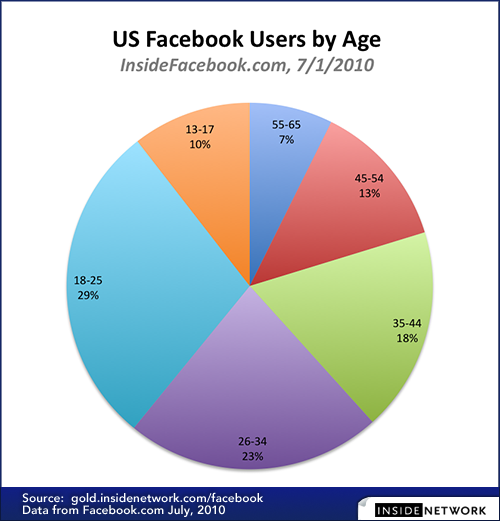Reluctance to embrace social media as an appropriate avenue for reaching arts patrons has often been blamed on the demographics of the user base. Many people look at sites like Facebook and immediately write them off as platforms only representing a younger generation. Not any longer.
 In 2010 educated adults over the age of 40 comprise the fastest growing demographic on Facebook, the age group 55+ grew by over 900%, and 40 million Facebook users in the US are now over the age of 40. This exposition of established professionals opens up the world of social networking even wider and begs the question: Are we properly using social media in the arts?
In 2010 educated adults over the age of 40 comprise the fastest growing demographic on Facebook, the age group 55+ grew by over 900%, and 40 million Facebook users in the US are now over the age of 40. This exposition of established professionals opens up the world of social networking even wider and begs the question: Are we properly using social media in the arts?
With 10 million Facebook users over the age of 55, Baby Boomers are staking their claim in the world of social media. This new demographic is college educated, professionally employed, and comprised of over 60% women. If that sounds familiar, you might be recalling the audience profile for the average arts patron in the U.S. The fastest growing segment on Facebook matches the traditional arts patron in the United States almost perfectly.
Other social media platforms have experienced similar growth outside of the traditional 18-34 age bracket. Currently users between 35 and 55 comprise the largest age bracket on Twitter. LinkedIn’s primary constituents are over 50 and MySpace continues its strong hold on original members now between the ages of 30 and 50.
These statistics along with the growing momentum around interactive websites, electronic outreach, and digital networking make social media the next frontier for audience development in the arts.
Innovations in social media within the arts have already sprouted around the country with great success:
- Characters from plays now have their own Facebook accounts to entice theatre goers to interact with them before and after the show.
- Interactive confession booths in galleries across the country load videos directly online for audiences to view and interact with.
- Viral online marketing is playing a larger and larger role in making buzz around productions and increasing web traffic.
But is it enough?
We can look to Australia for a prediction. Australia adopted social media faster that the US, UK or mainland Europe, with the highest user rates per capita in the industrialized world and the highest percent of users over the age of 35. Arts organization in Australia use Social Media to interact with patrons before, during, and after performances/exhibitions.
In the article Geeks, tweets and bums on seats, Elissa Blake discusses the adoption of social media in Australia and its affects on the arts. In the article, she writes about a production of King Lear where a woman asked permission to tweet during the performance. When asked why she did so, her response was:
It's about sharing your emotions and your experience of the show. You might have a favourite scene or a line that you love and you want to share it instantly. I thought King Lear might be dry, but it was really interesting, and I wanted my friends to go and see it...
Many Australian arts organizations and artists see social media platforms as a way for audience members to interact with companies, individual artist and each other. This interaction builds new passions for attending live performances as friends that could not attend receive enticing updates through their Twitter feed. This free viral marketing increases audience participation and makes Australia a leader of innovation in social media for the arts.
Fee Plumey, the digital program officer at the Australia Council for the Arts stated:
If arts companies want to attract new audiences, they have to jump in and chat about the minutiae of what's going on, Audiences are not just interested in a celebrity on stage. They really want to know how the show works, how the set was made, how it was cast, who's doing the lighting and what goes wrong… [social media provides that outlet].
Australia is a great case study for how social media can affect the arts. Now it is time for the US to see how social media can be creatively applied in audience development within our own country.
